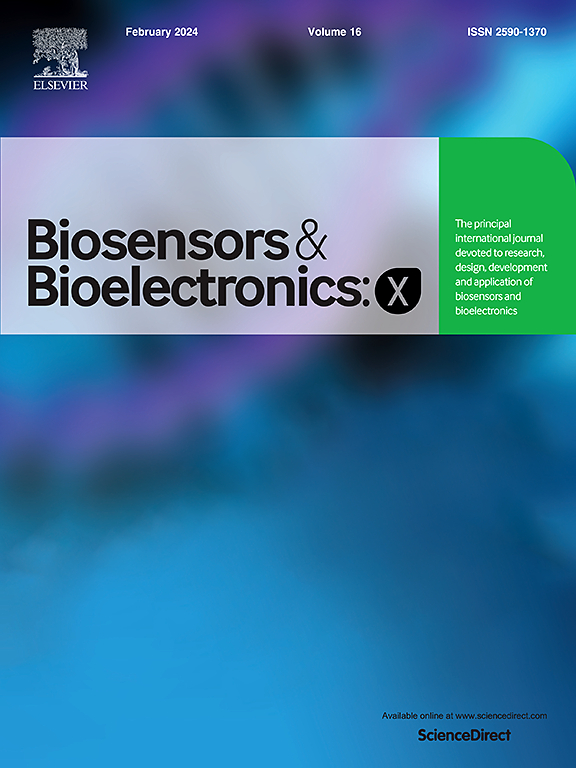用于SARS - CoV-2快速传感的电化学纳米生物传感器的设计与制造
IF 10.61
Q3 Biochemistry, Genetics and Molecular Biology
引用次数: 0
摘要
氧化石墨烯(GO)因其图案化特性、电子转移特性、高功能性和更大的表面积而成为一种生物传感材料,可实现敏感的使用点应用。本文设计了一种由聚碳酸酯轨迹蚀刻(PCTE)纳米筛平台和两个银电极组成的电化学生物传感器,该传感器可以快速灵敏地检测严重急性呼吸综合征冠状病毒2 (SARS CoV-2)表面糖蛋白,特别是刺突蛋白(s蛋白)。为了制备氧化石墨烯材料,我们利用改进的Hummers方法对石墨粉进行转化。在本研究中,我们采用常规或传统方法和蛋白g介导两种方法将SARS-CoV-2特异性抗体共价固定在EDC-NHS功能化纳米筛平台上。这些抗体通过生物连锁固定在纳米筛平台上,导致刺突蛋白与抗体之间的特异性相互作用。这些相互作用导致纳米筛的部分堵塞,从而导致1.0-2.0 V电压范围内离子电流的显著降低。线性范围设定在3.6 mM和3.6 aM之间。传统方法检出限为nM,蛋白g介导的抗体固定化法检出限明显降至fM。值得注意的是,当检测两种非特异性蛋白质,牛血清白蛋白(BSA)和流感病毒时,在相同的设置下,电流没有显着变化。这种纳米生物识别平台或纳米生物传感器,由于集成了少量氧化石墨烯层压板,提供了更好的稳定性和更高的灵敏度。本文章由计算机程序翻译,如有差异,请以英文原文为准。
Design and fabrication of an electrochemical nano-biosensor for the quick sensing of SARS CoV-2
Graphene oxide (GO) emerged as a biosensing material due to its patternable features, electron transfer properties, high functionality, and greater surface area that enables sensitive point-of-use applications. This report outlines the design of an electrochemical biosensor composed of a polycarbonate track-etched (PCTE) nano-sieve platform with two silver electrodes, which can detect the surface glycoprotein of the severe acute respiratory syndrome coronavirus 2 (SARS CoV-2), specifically the Spike protein (S-protein), in a rapid and sensitive manner. To fabricate the GO material, we utilized the modified Hummers' method to convert graphite powder. In this study, we covalently immobilized SARS-CoV-2 specific antibodies onto an EDC-NHS functionalized nanosieve platform using two methods i.e., conventional or traditional method and protein-G mediated. The immobilization of these antibodies on the nanosieve platform was achieved through bio-linkage, resulting in specific interactions between the spike protein and the antibodies. These interactions led to a partial blockage of the nanosieve, this led to a considerable decrease in the ionic current for a voltage range of 1.0–2.0 V. The linear range was set between 3.6 mM and 3.6 aM. The detection limit was in nM in traditional method which was notably decreased to fM in protein-G mediated antibodies immobilization. Notably, when testing two non-specific proteins, bovine serum albumin (BSA) and influenza virus, under the same settings, there was no significant change in the current. This nano-biorecognition platform, or nanobiosensor, offers improved stability and higher sensitivity due to the integration of minor GO laminates.
求助全文
通过发布文献求助,成功后即可免费获取论文全文。
去求助
来源期刊

Biosensors and Bioelectronics: X
Biochemistry, Genetics and Molecular Biology-Biophysics
CiteScore
4.60
自引率
0.00%
发文量
166
审稿时长
54 days
期刊介绍:
Biosensors and Bioelectronics: X, an open-access companion journal of Biosensors and Bioelectronics, boasts a 2020 Impact Factor of 10.61 (Journal Citation Reports, Clarivate Analytics 2021). Offering authors the opportunity to share their innovative work freely and globally, Biosensors and Bioelectronics: X aims to be a timely and permanent source of information. The journal publishes original research papers, review articles, communications, editorial highlights, perspectives, opinions, and commentaries at the intersection of technological advancements and high-impact applications. Manuscripts submitted to Biosensors and Bioelectronics: X are assessed based on originality and innovation in technology development or applications, aligning with the journal's goal to cater to a broad audience interested in this dynamic field.
 求助内容:
求助内容: 应助结果提醒方式:
应助结果提醒方式:


